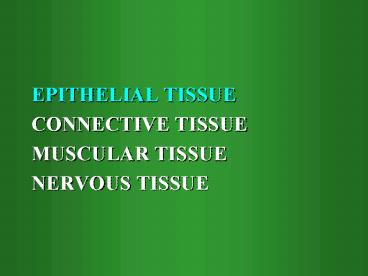EPITHELIAL TISSUE - PowerPoint PPT Presentation
1 / 53
Title: EPITHELIAL TISSUE
1
- EPITHELIAL TISSUE
- CONNECTIVE TISSUE
- MUSCULAR TISSUE
- NERVOUS TISSUE
2
Respiratory Passages Pleural cavities Hart
and Blood vessels Pericardium
Oral cavity Skin Digestive Tract Peritoneum
Urinary tracts Glands Limph vessels
3
FUNCTIONS OF EPITHELIA
- COVERING EPITHELIA
- covering of surfaces and lining of cavities
- protection of covered tissue
- absorption - intestines, proximal tubules of
kidney - GLANDULAR EPITHELIA
- secretion - exocrine glands
- NEUROEPITHELIAL CELLS
- sensation - olfactory epithelium , taste buds
- MYOEPITHELIAL CELLS
- contractility - salivary glands, sweat glands
4
(No Transcript)
5
COMPONENTS OF BASAL LAMINA
- COLLAGEN TYPE IV
- LAMININ, FIBRONECTIN (glycoproteins)
- PROTEOGLYCANS - (HEPARAN SULFATE)
- ANCHORING FIBRILS - COLLAGEN TYPE VII
6
FUNCTIONS OF BASAL LAMINA
- Selective barrier between connective tissue and
epithelium - Adhesion of the connective tissue and the
epithelium
7
POLARITY OF EPITHELIA
- APICAL SURFACE
- BASAL SURFACE - rests on basal lamina
8
TYPES OF EPITHELIA
- ACCORDING TO NUMBER OF LAYERS
- simple
- stratified
- pseudostratified
- ACCORDING TO SHAPE OF CELLS
- squamous
- cuboidal
- columnar
9
- SIMPLE SQUAMOUS EPITHELIUM
- endothelium, mesothelium
10
SIMPLE SQUAMOUS EPITHELIUM
11
- SIMPLE CUBOIDAL EPITHELIUM
- proximal and distal renal tubules
12
- SIMPLE CUBOIDAL EPITHELIUM
13
- SIMPLE COLUMNAR EPITHELIUM
- stomach, small and large intestine, oviduct
14
- SIMPLE COLUMNAR EPITHELIUM
15
- PSEUDOSTRATIFIED EPITHELIUM
- respiratory passages, epididymis
16
- STRATIFIED SQUAMOUS EPITHELIUM
- keratinised - skin
- nonkeratinised - oral cavity, vagina
17
STRATIFIED SQUAMOUS EPITHELIUM
keratinised nonkeratinised
Skin
Cornea
Esophagus
18
- STRATIFIED COLUMNAR EPITHELIUM
- ocular conjunctiva
19
- TRANSITIONAL EPITHELIUM
- urinary bladder, ureter
20
INTERCELLULAR JUNCTIONS
- membrane associated structures responsible for
cohesion and communication between cells - ADHERING JUNCTIONS
- IMPERMEABLE JUNCTIONS
- COMMUNICATING JUNCTIONS
21
TIGHT JUNCTION - ZONULA OCCLUDENS
- LOCATION - the most apical
- SHAPE - band encircling the cell
- MORPHOLOGY - network of linear fusion sites
between membrane associated proteins - FUNCTION - close off the intercellular space
(leakiness of the epithelium)
22
TIGHT JUNCTION - ZONULA OCCLUDENS
23
TIGHT JUNCTION - ZONULA OCCLUDENS
Prevent the flow between the cells
Prevent the movement of membrane proteins
24
DESMOSOME
25
DESMOSOME -MACULA ADHERENS
- LOCATION - along the lateral membranes
- DISK-SHAPED
- MORPHOLOGY -
- attachment plaques - desmoplaquin
- intercellular space - desmoglein
- cytokeratin filaments
- FUNCTION - very firm adhesion of neighbor-cells
26
ZONULA ADHERENS
27
ZONULA ADHERENS
- LOCATION - just below tight junction
- SHAPE - band encircling the cell
- MORPHOLOGY -
- dense plagues - a-actinin, vinculin,
myosin, tropomyosin - intercellular space - E-kadherin and
calcium ions - actin-containing microfilaments
- FUNCTION - adhesion of neighbor-cells
28
HEMIDESMOSOME
- LOCATION - contact zone between epithelium and
basal lamina - DISK-SHAPED
- MORPHOLOGY - half a desmosome
- FUNCTION - binds the epithelial cell to basal
lamina
29
INTERCELLULAR JUNCTIONS
- Electron transmission microscope
30
GAP JUNCTION -NEXUS
- LOCATION - anywhere along the lateral membranes
of epithelial cells - MORPHOLOGY - hexamers of proteins with a
hydrophilic pore in the center (connexon) - FUNCTION - interchange of small molecules
between adjacent cells (cyclic AMP, ions)
31
GAP JUNCTION -NEXUS
32
GAP JUNCTION - NEXUS
33
MICROVILLI
- Extension of cytoplasm - 1mm long
- Actin-containing microfilaments
- FUNCTION - increase the surface area
- LIGHT MICROSCOPE - BRUSH BORDER
34
MICROVILLI
35
MICROVILLI brush border
36
CILIA
- LONG PROJECTIONS - 10 mm
- MOTILE
- STRUCTURE
- central pair of microtubuls
- 9 pairs at the periphery
- INSERTED INTO BASAL BODIES
- FUNCTION - permit a current of material over
epithelium
37
CILIA
38
STEREOCILIA - long microvilliFLAGELLA -
similar in structure to cilia
39
GLANDULAR EPITHELIA - Glands
- FUNCTION - secretion of products which are used
in other parts of the organism
40
(No Transcript)
41
42
(No Transcript)
43
SEROUS GLANDS
- ACINAR SECRETORY PORTIONS
- SECRET CLEAR FLUID SECRETION
- SEROUS CELLS
- ruonded nucleus at basal part of cytoplasm
- abundant RER
- basophilic cytoplasm
- well visible secretory granules at the apex
44
SEROUS CELLS
45
MUCOUS GLANDS
- TUBULAR SECRETORY PORTIONS
- SECRET MUCUS
- MUCOUS CELLS
- flat nucleus at the basis
- large, translucent secretory granules
- well developed Golgi complex
46
(No Transcript)
47
(No Transcript)
48
(No Transcript)
49
SUBLINGUAL GLANDS
50
TYPES OF EXOCRINE GLANDS
APOCRINE secretory product is discharged with
apical part of cytoplasm
HOLOCRINE secretory product is shed with whole
cell
- MEROCRINE
- secretory granules leave the cell by exocytosis
51
(No Transcript)
52
NUTRITION OF EPITHELIA
- NO BLOOD VESSELS IN EPITHELIA
- NUTRIENTS AND PRECURSORS OF PRODUCTS DIFFUSE FROM
CONNECTIVE TISSUE ACROSS THE BASAL LAMINA TO
EPITHELIAL CELLS
53
RENEWAL
- REPLACEMENT OF OLD CELLS BY NEW ONES
- MITOTIC DIVISIONS
- OCCUR IN ALL EPITHELIA































